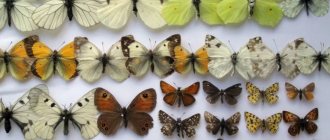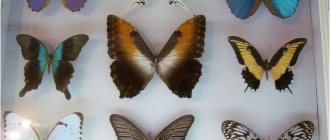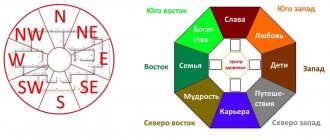This article shows you how to make a beautiful collection of dried insects.
Previously, there were many collectors of dried insects. Almost every third person tried to preserve a beautiful butterfly or some kind of beetle, for example, between the pages of an old book. Naturally, there are still real collectors today, despite the projects of Greenpeace and other environmentalists. But still, the real keepers of rare specimens remain.
If you decide to start creating collections of dried insects, then read the information below. Here you will find answers to questions about how to do it correctly in stages, as well as how to register and much more. Read on.
What is the name of the collection of dried insects and butterflies?
Collection of dried insects, butterflies
A collection of dried insects is called an entomological collection. It should be noted that specimens are pinned with a special pin and selected for certain distinctive features. They are stored in special boxes. Collecting butterflies is called lepidopterophilia.
Do not under any circumstances call an entomological collection a herbarium, since this concept applies only to plants.
How to catch insects for collection: recommendations
Catching insects for a collection
Collecting an entomological collection is possible only for the purpose of expanding the knowledge of young naturalists. As for chasing insects for fun, this is strictly prohibited. In general, children collect butterflies, beetles and other common insects that can be encountered during walks. How to catch insects for collection?
Here are important nuances and recommendations for a young or adult collector:
- You should not dress in the latest fashion - clothes should be simple and comfortable.
- Particular attention should be paid to shoes. Ideally, it should protect your feet from cold and dampness. Wear resistance is also important.
- The headgear should not distract from fishing or fall off during a fast run. It is inconvenient to hold it with your hands.
It is important to know the time:
- It is better to catch insects in May and June.
- However, there are some species that are found towards the end of summer.
- It is best to choose the afternoon hours, since most insects fly in the hottest time, after lunch.
Let's say moths hide when the sun goes down. If the insects are nocturnal, of course, they are caught after sunset. It is very easy to catch insects before a thunderstorm. The air is stuffy, and the stuffiness forces them to leave their shelters.
The better way to catch butterflies and other beetles, mosquitoes, moths and so on:
- As a rule, naturalists use special nets.
- A stick serves as support.
- This net is a strong wire circle with a diameter of about 30 cm . Attached to it is a cone-shaped bag made of lightweight fabric.
How to catch an insect:
- You should approach carefully.
- The shadow should be behind the insect, and not in front - otherwise it will slip away.
- The net should be cast quickly and accurately, surrounding the insect and preventing it from escaping.
- In addition to the mesh, there must be scissors made of strong iron wire.
Where are butterflies, beetles, moths, mosquitoes and other “bugs” with wings found:
- Often these are fields, the edge of a forest with flowers, meadows, etc.
- Moths can be caught as dusk approaches. Then there are swarms of small midges.
- You can attract butterflies by watering the branches of a tree with a mixture of honey, water and white beer or sugar water.
They should gather on one of the branches and this will make it easier to catch them. Watch a video of how Canadian scientists catch insects using convenient and interesting methods:
Description of the butterfly
Daytime butterflies of the peacock eye species belong to the order Lepidoptera and the family Nymphalidae. Insects are medium in size - wingspan 50-65 mm, body length 27-30 mm. Females are slightly larger than males. The main color of the wings is red or red-brown. An individual feature of the species is 4 large “eyes” located on each wing. Spots of various shades of blue are bordered with black and white.
The characteristic pattern is a defense mechanism against predators. When attacked by birds, the insect opens its wings, disorienting the enemy. This is usually enough to scare away small birds such as sparrows. A predator may partially damage the tip of its wings, but the butterfly will not lose its ability to fly.
On the back of the wings there is a protective coloring. Yellowish wavy stripes and dots on a black-brown background help blend into the surface of trees, dry leaves and plant debris. The inconspicuous appearance of the peacock butterfly with folded wings provides camouflage from enemies in winter and summer.
Life cycle
Lepidoptera are insects with a full cycle of transformation. They go through 4 stages of development: egg, caterpillar, pupa and adult. In the peacock eye species, this takes about 1 year. Overwintered females mate with males in the spring. In May, they lay up to 300 eggs on food plants: nettle, raspberry, willow, hop. The caterpillars are black in color, their body is covered with white dots, hairs and prickly spines. They live in large groups, eating plants to the ground. Spread before pupation. The pupal stage lasts 1-2 weeks.
Information. In northern latitudes, one generation appears per season, in southern latitudes - two. The first adult years are from June to July, the second - from August to September.
Females of the second generation live up to 6 months. Half of their life is spent in a state of suspended animation. With the onset of cold weather, the adults fall asleep, and in the spring they flutter over the flowers again.
Habitat
The diurnal moth is widespread throughout Europe and Asia. Insects avoid flying into areas of the far north and tropical deserts. The largest population settled in Germany. And on the island of Crete there are no representatives of the species. Butterflies are found in forest clearings, ravines, fields, gardens and squares, and in cities. In the mountains they live at an altitude of 2-2.5 thousand m above sea level.
How to kill insects for an entomological collection?
Insects in the entomological collection
This should be done quickly and humanely. You shouldn’t let a living creature suffer for a long time. This develops cruelty in children. Little butterflies just get squeezed. Larger insects can be doused with hot water. Or put sulfuric ether at the bottom of the box.
About punctures:
- The puncture with a pin is carried out in the middle of the chest.
- You need to carefully pass the pin through the entire body.
- The insect should be spread out on a damp board. It should dry.
- Each board should be equipped with a piece of paper glued with gum arabic. This makes it easier to determine what species or type the insects belong to.
- They should be stored in boxes with cork or peat at the bottom.
- It is best to prick butterflies from top to bottom.
- Before the box is closed, a bottle of gasoline is dropped into it. It protects against moths and bugs.
- If the butterfly has wrinkled over time, it should be placed under a glass cover and then straightened.
Worth knowing: If mold appears on a bug, then lubricate this area with a brush with alcohol or ether.
Here's more information on how to kill insects for an entomological collection:
- Collectors should remember that killing insects is, in this case, a necessary necessity, and not a way of obtaining pleasure.
- As a rule, specially made stains are used. This is the most painless way to take the life of an insect.
- They can be with sulfuric or acetic ether, or chloroform.
You can make stains using tall glasses made of thick glass or jars. It’s great if you can seal the stain with a cork stopper.
Tip: Place some tissue paper at the bottom of such a glass or jar. This is especially necessary if you want to dry several insects at the same time. This method helps to prevent insects from rubbing and forming a ball. Butterfly stain does not require paper.
It's also worth remembering:
- There should be several stains. Large beetles should not be placed in the same container as flies, etc.
- In order to kill insects, you need to wet the cotton wool with the above mentioned agents. Vapors from various ethers and alcohols can kill living organisms.
- Acetic ester kills more slowly. However, insects killed in this way are softer.
- If there is no ether or chloroform, you can use gasoline.
Precautionary measures: Ether and gasoline are flammable substances. Therefore, when using them to treat insects, be careful.
HIGH TEMPERATURE to kill insects. This method is suitable if you do not have poisons or do not want to use them. To do this, do the following:
- Take a tin or zinc jar.
- Close the lid tightly.
- Place in boiling water.
Don't do this to insects that have developed jaws. They can ruin other copies.
Killing can be carried out in wine alcohol:
- Dip the insects into a container with this substance and you’re done.
- But it is important to remember that this is suitable for those who do not have long, bright hairs or scales.
- That is, you can only kill dark-colored beetles this way. The alcohol strength must be at least 60°.
As you can see, each type of beetles, butterflies, moths, mosquitoes and other insects has its own method of killing.
Carefully straighten the exhibit
Once the butterfly has died, it must be prepared to be placed under glass before it dries out and the wings freeze in an inappropriate position. An experienced lepidopterist knows this and always has the appropriate equipment at the ready.
In general, various devices can be used. Some people prefer to purchase special ones, which are sold in specialized stores and are quite expensive. Others decide to make equipment with their own hands, at least for the first time, until it becomes clear whether this hobby will be an ordinary, quickly boring whim or will remain for life.
The easiest option is to take a board of soft wood and make a narrow and not too deep slot in it according to the size of the trophy’s body. Any beginning butterfly collector can do this.
Carefully place the euthanized insect on the board so that the body fits into this gap. Now very carefully straighten the wings and press them against the tree. Place a piece of thin polyethylene (a transparent disposable bag will do) or tracing paper on top of each wing and secure with pins. At the same time, try not to bury the body too deep into the gap so that it is at the same level as the wings. Then your trophy will look most elegant and will become a magnificent decoration of the collection.
How to dry insects for collection: general recommendations
Collection of insects
An insect should be dried immediately after it is caught. If it is necessary to dry the beetle, it is glued to the foam with glue. You definitely need to straighten his paws and secure them with pins.
- After the insect has dried, you need to carefully remove it from the foam and then glue it onto a cardboard block.
- It is important to protect the collection from pests.
Insects are attached to the foam with pins if they are dry. There should be a piece of paper with the name next to it. The foam is placed in a box and put away in a warm and dry place. As a rule, drying lasts about a week. But everything can be ready earlier. The beetles will take up to a month to dry. The period depends on the size of the insect and the region where it was caught.
Dangers of insects in winter
Most insects survive the winter cold at the pupal stage; the cocoon provides additional protection from frost and microorganisms. Some butterflies migrate from the cold to southern latitudes, where they safely survive the winter season. But the peacock's eye, just like the urticaria and lemongrass, awaits the arrival of spring in its habitats. He hides in a pile of autumn leaves and plunges into suspended animation.
Global warming has a negative impact on wildlife. Increasingly, thaws occur in the middle of winter with an average daily plus temperature of up to 10 °C. Because of the heat, insects and animals wake up early. In winter, you can see a peacock butterfly emerging from a hollow or other shelter. This is a disastrous awakening. The insect wastes energy in vain, and it may not be able to find another suitable place to continue hibernation.
Information. For a successful winter, butterflies need dry shelter. In a humid environment, they are attacked by deadly fungal infections.
Not all butterflies will be able to survive the cold season. There are several reasons for the death of insects:
- They often starve to death when they cannot store enough energy in the fall.
- They become food for birds or animals. Small rodents, most often mice, look for food in hollows, outbuildings, and forest litter in winter.
- They die from various infections.
Waking up in the spring after wintering, peacock butterflies look for any food sources - primroses, dandelions. They flutter over flowers, collecting nectar, looking for juice that appears on the bark of trees. Males occupy sunny areas and wait for overwintered females to appear for mating and procreation.
How to dry butterflies for a collection?
Butterfly collection
So, how to properly dry butterflies for a collection? Here are some important nuances:
- The main thing is to spread your wings. This needs to be done correctly.
- If the insects have just been caught, you can immediately begin the process.
- And if the butterflies are dried, then they need to be soaked.
- This can be done in a glass desiccator or in a saucepan. Sand is poured there (preferably it should be fine, river sand, sifted through a sieve, and kept in boiling water).
- Drain the water and use the sand to arrange the bags of butterflies.
- Instead, you can use cotton wool or damp foam rubber. The butterfly is soaked in water vapor.
- Cover the pan tightly with a lid.
Tip: Add phenol to the water. It will save you from rot and mold, but this substance is considered very toxic.
Small butterflies can be straightened out the very next day. Large ones take a little longer. You can add water to a syringe and inject it into the insect's chest, where the wings begin. This will speed up the process. It's also worth knowing the following:
- If the butterflies are rare and delicate, they can be put on a pin right away.
- If the insect's head is turned to one side, it should be adjusted with tweezers so that it takes a normal position.
- Insects are spread out by spreading.
- It is necessary to position the insect so that its body is in the groove and its wings are located on the planks. The basis for straightening is a wooden plate.
- On some products, the distance between the boards is adjusted using a screw.
The process of laying the butterfly out:
- Insert a pin with a butterfly into the groove, perpendicular to the longitudinal and transverse axes.
- The bases of the wings should be located at the upper edges.
- Stick it to the right of the abdomen - otherwise the butterfly may start to turn.
- Place pieces of cellophane or tracing paper on the wings, which are held on boards. They should cover the wings almost completely.
- Use a long tailor's pin. Use it to carefully move the wing until the top edge is perpendicular to the longitudinal axis.
- Then move the rear fender. It should go under the front one.
- The other pair of wings moves similarly. By the way, don't pierce the wings. This will ruin their appearance.
Tip: Pin along the edges. The wings should be pressed against the planks and not be displaced. Place cotton wool under the belly to prevent it from drooping, and place the mustache along the front edge.
The butterflies take several days to dry. And then their body retains its properties. By the way, insects that have just been caught take longer to dry than those that have been soaked.
When the butterfly has already been removed from straightening:
- It needs to be labeled.
- Indicate on it the name of the region where the butterfly was caught, the date, and the name of the catcher.
This design of the collection allows you to preserve the insect in a beautiful form for a long time, and the label will not allow you to forget all the necessary information.
Description of the butterfly
Daytime butterflies of the peacock eye species belong to the order Lepidoptera and the family Nymphalidae. Insects are medium in size - wingspan 50-65 mm, body length 27-30 mm. Females are slightly larger than males. The main color of the wings is red or red-brown. An individual feature of the species is 4 large “eyes” located on each wing. Spots of various shades of blue are bordered with black and white.
The characteristic pattern is a defense mechanism against predators. When attacked by birds, the insect opens its wings, disorienting the enemy. This is usually enough to scare away small birds such as sparrows. A predator may partially damage the tip of its wings, but the butterfly will not lose its ability to fly.
On the back of the wings there is a protective coloring. Yellowish wavy stripes and dots on a black-brown background help blend into the surface of trees, dry leaves and plant debris. The inconspicuous appearance of the peacock butterfly with folded wings provides camouflage from enemies in winter and summer.
Life cycle
Lepidoptera are insects with a full cycle of transformation. They go through 4 stages of development: egg, caterpillar, pupa and adult. In the peacock eye species, this takes about 1 year. Overwintered females mate with males in the spring. In May, they lay up to 300 eggs on food plants: nettle, raspberry, willow, hop. The caterpillars are black in color, their body is covered with white dots, hairs and prickly spines. They live in large groups, eating plants to the ground. Spread before pupation. The pupal stage lasts 1-2 weeks.
Information. In northern latitudes, one generation appears per season, in southern latitudes - two. The first adult years are from June to July, the second - from August to September.
Females of the second generation live up to 6 months. Half of their life is spent in a state of suspended animation. With the onset of cold weather, the adults fall asleep, and in the spring they flutter over the flowers again.
Habitat
The diurnal moth is widespread throughout Europe and Asia. Insects avoid flying into areas of the far north and tropical deserts. The largest population settled in Germany. And on the island of Crete there are no representatives of the species. Butterflies are found in forest clearings, ravines, fields, gardens and squares, and in cities. In the mountains they live at an altitude of 2-2.5 thousand m above sea level.
How to properly dry a dragonfly with open wings at home?
Using the example of a butterfly, also dry a dragonfly.
A dragonfly is as fragile as a butterfly. Her wings can be broken with one wrong movement of the hand. If you decide to dry it, then you need to do it correctly. Many people simply place the dragonfly on a piece of cotton wool. This method is not successful, since insects dried by this method are not stored for a long time. How to properly dry a dragonfly with open wings at home? Here are a few nuances:
- The dragonfly should be pinned. This is the most optimal storage method.
- Sometimes before drying a dragonfly, it needs to be steamed. This is required when it has lain in its original form for a long time.
- First, place it in a humid chamber. This can be either a crystallizer, a glass bath, or just a deep plate.
- Washed sand is placed at the bottom of this container. An insect is placed on top.
- It is necessary that the vessel closes well.
Worth knowing: It is prohibited to prick insects when they are dry - they may break. The first thing a dragonfly needs to do is spread its wings.
This can be done using the same method as spreading the wings of a butterfly. Read the text above.
- Place the dragonfly on a special groove, holding it with your fingers.
- With your right hand, stick a pin into it.
- Then take the insect with two fingers and push it to the maximum depth.
A pin is inserted perpendicular to the upper surface of the insect, towards the surface of the outstretched wings. You need to have enough room for your fingertips between the head of the pin and the insect. To do this, do the following:
- Take the pin by the head without hitting the insect.
- Be sure to straighten the already pinned dragonfly.
- Bend your legs closer to your body. They shouldn't hang around. However, they must maintain a natural position.
- Pin the legs with pins until the insect dries.
- The spread wings should be laid horizontally.
Remember: When straightening the dragonfly, take it with tweezers, not with your hands. The needle is carefully inserted into the vein so as not to damage the wings or tear them.
To prevent the bright pattern on the sides of the thoracic segments and abdomen of the dragonfly from disappearing, you need to treat it with acetone. When the dragonfly falls asleep in the stain, you need to take it out, holding it by the wings that are folded together, and then dip it in acetone. But not with my head. You should keep it in this state for a couple of hours, and then keep it on the air for an hour.
After this, the dragonfly is dried and placed on a mattress. Maintaining correct coloration is important for species identification. Coloring is an important indicator of a particular insect.
A butterfly flew into the apartment) what to do with it? It's snowing outside (((it's cold
It's easy and interesting to communicate here. Join us!
let it live, feed it Keeping butterflies does not require much time for care, expensive feed or walking in any weather. A winter garden or greenhouse greatly simplifies the task, but is not at all necessary. Even in a residential apartment (in summer), special equipment is not necessary. Winter requires more delicate maintenance of butterflies, due to the presence of heating devices in apartments - dry air is destructive for tropical beauties. A glass insectarium 75/75/100 cm is suitable for home maintenance. You can decorate it with decorative driftwood and various plants. The lifespan of butterflies depends on the species and conditions of keeping the butterflies. There are two types of butterflies that differ in their feeding options. The first group of butterflies consume only nectar, such as the Papilios and Nymphalidae species. The nectar simply serves to replenish expended energy hence the lifespan of these species is short from one week to one month under favorable conditions. The second group of butterflies belonging to families such as Heliconidae and Morphidae. They feed on both nectar and plant pollen. Pollen is a source of protein, and protein allows you to build and renew areas of muscle and organ tissue. The lifespan of such butterflies is approximately three months. The butterfly should be fed once a day if it is active. Otherwise, once every 1.5 days. Butterflies feed on a 10% solution of water and honey. Honey should not contain preservatives. The largest butterflies prefer thicker mixtures, for example, a 20-30% solution of apricot nectar. It is better to purchase apricot nectar from baby food. You should not hold the butterfly while feeding. When feeding, you can see how expressively the butterfly's proboscis moves. The larger the butterfly, the more noticeable the movements of the proboscis. Feeding takes from 2 to 15 minutes. When the butterfly satisfies its hunger, it flies away from the feeder. It is easiest to pick up a butterfly when it is with its wings folded. This is not difficult to do, since the larger the butterfly, the slower and more graceful it flies. So if you didn’t succeed in picking up the butterfly the first time, don’t despair. It will smoothly fly to another place, and you can try again. Try to take it closer to the base of the wings. As a rule, the lifespan of a butterfly does not exceed 10 days, but with proper maintenance it can be extended to 3 weeks or even more. At night, place the butterflies in a box with a damp sponge or a piece of cotton wool soaked in water inside. Leave the box of butterflies in a cool place. In the morning, wake up the butterflies by opening the box and moving it to a warmer place.
How to properly dry a grasshopper or praying mantis at home?
Properly dried grasshoppers and praying mantises at home
The main disadvantage of drying a grasshopper and a praying mantis is that it will turn from a green “handsome” into a brown, wrinkled insect. It is very difficult to bypass this process. How to properly dry a grasshopper or praying mantis at home? Important details:
- As mentioned above, it is important that insects do not turn black when dried and retain their color.
- Therefore, before starting the process, it is better to gut them - otherwise they will take a long time to dry and retain an unpleasant odor.
This all needs to be done in the following sequence:
- After grasshoppers and mantises are caught, they are killed in the stain. It is necessary that the jar has a wide neck and strips of paper at the bottom.
- To “stain” you need ether. Evaporate it in a jar, then place the insect and close the container for several hours.
- After this, the insects are immediately straightened and impaled. This is done on the first day, while they are still wet. Otherwise, there is a risk of breaking limbs, and for grasshoppers and mantises this is the most important thing.
- Insert pins into the grasshoppers' right elytra.
- After this, wait until the insect dries.
- The paws should be closer to the body so as not to break them.
Then label the collection and place it in a permanent storage location.
Dangers of insects in winter
Most insects survive the winter cold at the pupal stage; the cocoon provides additional protection from frost and microorganisms. Some butterflies migrate from the cold to southern latitudes, where they safely survive the winter season. But the peacock's eye, just like the urticaria and lemongrass, awaits the arrival of spring in its habitats. He hides in a pile of autumn leaves and plunges into suspended animation.
Global warming has a negative impact on wildlife. Increasingly, thaws occur in the middle of winter with an average daily plus temperature of up to 10 °C. Because of the heat, insects and animals wake up early. In winter, you can see a peacock butterfly emerging from a hollow or other shelter. This is a disastrous awakening. The insect wastes energy in vain, and it may not be able to find another suitable place to continue hibernation.
Information. For a successful winter, butterflies need dry shelter. In a humid environment, they are attacked by deadly fungal infections.
Not all butterflies will be able to survive the cold season. There are several reasons for the death of insects:
- They often starve to death when they cannot store enough energy in the fall.
- They become food for birds or animals. Small rodents, most often mice, look for food in hollows, outbuildings, and forest litter in winter.
- They die from various infections.
How to dry a spider for collection?
Dried spider for collection
The best time to catch and dry spiders for collection is in August or September. At this time there are the most mature individuals. For fixation, you can use 96% alcohol or 10% formaldehyde. The smaller the spider, the more difficult the drying process. You should not kill spiders thoughtlessly. In such cases, their limbs bend and freeze.
It is better to put the victim to sleep:
- Place the spider in the jar.
- Instead of a lid, use a cotton swab soaked in formaldehyde.
- After a while, the paws need to be straightened with a pin on the board, that is, straightened.
- Entomological pins must be of standard length and have round heads. Regular ones cannot be used. They rust quickly. This must be done when the spider is already dead. The paws are straightened and fixed. For this you need pins and strips of paper.
- It is important not to break anything for the spider. But at the same time, there should be no contractions in the paws; reliable fixation is also important.
- Spiders should be stored in a dark, dry place.
Here's another way to dry a spider. Also suitable for various beetles. You will need the following:
- A jar that will be used for stain.
- The thicker paper will be used for mattresses and labels, and the softer paper will need to be filled with stain and made into “mattresses”.
- Use ethyl acetate or nail polish remover as a poison.
- You will also need cotton wool, thread, needles and cardboard boxes.
- Containers - plastic and metal.
- You also need glue and binoculars.
Do the following:
- Fill the jar with paper, which must first be cut into strips. You can crumple it up. This is necessary to ensure that the specimens are clean and dry.
- Then add a few drops of the polish remover liquid there. This is an analogue of ethyl acetate. It poisons insects, but does not make the integument fragile.
- Now cut out the bases for the mattresses - you can put a box, for example, of sugar, on the sheet.
- Fold the edges and cut rectangles at the corners. All blades are bent twice - at the edge and after half a centimeter.
- Insects or spiders are laid out on a mattress and mounted on pins.
For each mattress, cut out a rectangle to place on the bottom (thick paper) and a rectangle of soft, thin paper (to cover). There must be cotton wool on top of the dense fabric. Now place the frozen insects. But you can prick them right away. Once the insects are dry, they can be soaked. To do this, the mattress is placed in a closed pan with damp cotton wool at the bottom.
When the insect or spider is dried, you need to write explanations on a covering of thin paper. As a rule, this is the region and the surname of the young researcher. If the type of insect is unknown, you should take a key and find it using identification marks.
How to dry a bumblebee: tips
The dried bumblebee for the collection of
Bumblebees and Hornets must first be poured into resin or acrylic for the collection. Simply because a stinging insect is dangerous enough to poke with a pin while it is still alive. Here are tips on how to dry a bumblebee:
- To begin with, the individual should be caught in a container. It can be a jar or a box.
- Plant in a jar of epoxy resin with hardener or acrylic. For this you will need disposable containers.
- Mix the “fill” thoroughly.
- The process itself has three stages. First you need to fill the first layer, put an insect there (beetle, bumblebee, wasp) and pour it. Before this, you should give the beetle the desired pose. The last stage is to fill everything completely.
- After the insects drown, they need to be taken out and spread on the foam with pins and allowed to dry.
Important: The main thing is not to prick yourself on the sting and make sure that the insect no longer shows signs of life. Quite often, bumblebees, bees and wasps can only pretend that they are unconscious, and after a person takes them in his hand, they sting.
By the way, you can give the bumblebee the desired pose with tweezers or another sharp object, even a nail. The main thing is to be careful. The beetle should lie tightly. There is no need to fill it with the entire portion of resin or acrylic at once, otherwise it may move. Watch the video on how to soak and straighten insects. The collector clearly shows this.
How to decorate a collection of insects with your own hands: ideas
There are more than a million species of insects in the world. Each of them is truly unique. A collection of insects, even collected by an amateur, also has its value. This is why many people are interested in creating collections. It is important to arrange it correctly so that you can display it or simply store it. Below you will find ideas to help you decorate your insect collection with your own hands.
The simplest option is to place the insects on a paper mattress or foam, place them in a frame and cover them with glass.
DIY insect collection
Here are the original collections of butterflies.
DIY insect collection
DIY butterfly collection
You can create compositions using jars and glasses. Also use dry branches, moss and other natural materials.
DIY butterfly collection
In the middle you can place the most beautiful and rare beetles, which will be the center of attention.
DIY beetle collection
Large dried insects look beautiful in separate glass containers.
DIY beetle collection
In one large box you can make sections, in each of which you can place insects from a separate region.
DIY beetle collection
Is it possible to transport collections of dried insects to the Russian Federation purchased abroad?
There is a lot of controversy over whether it is possible to transport insects purchased abroad to your homeland. On the one hand, customs may not look at the contents of your hand luggage. But it is better not to transport them in alcohol. Since it is prohibited to bring liquids with a volume of more than 100 ml .
- Insect collections are often transported in the luggage compartment. Naturally, in some cases the legislation requires a special permit for the transportation of animals.
- But some naturalists manage to ignore the “voice of the law” and transport their collections in some kind of container (for example, inside a guitar or double bass), thereby ignoring paperwork.
- Naturally, airport workers can detect this and then they will have to answer according to the Law.
In the question “is it possible to transport collections of dried insects to the Russian Federation purchased abroad”, everything depends on many factors:
- Number of insects in the collection.
- Their uniqueness and value for the state from which they are exported.
- Availability of permission and accompanying documents.
- Individual airline requirements and other conditions.
Therefore, before transporting your collection, you should consult the airport help desk or call the operator at the airline’s phone number. They will answer all the necessary questions and explain the conditions for transporting certain luggage or the contents of hand luggage.
Butterfly in the apartment: how to get rid of it?
The butterfly, or as it is also called the “common butterfly”, “drain fly”, belongs to the order of “two-winged” insects.
In another way, the butterfly is called a “drainage fly”, since in appearance it resembles a fly. But, nevertheless, it has features and some structural features inherent in moths. It is known from reliable sources that the butterfly is a close relative of the mosquito.
Length of insects: from 1 to 4 millimeters. The rest of the body is covered with down, including the wings. The color of the butterfly depends on the area of residence, but most often we come across butterflies of silver and steel colors.
These insects can be seen in any part of the globe, as their species is quite common. According to scientific data alone, about 28,867 species of butterflies are known. How many there are in reality is unknown.
A separate subspecies that deserves attention is the synanthropic species of butterflies. This is a special type of butterfly that loves damp rooms and lives in human habitats - apartments, houses.
Where can you see real state collections of insects collected by scientists?
A real state collection of insects collected by scientists
You can see real state collections of insects collected by scientists in museums. As a rule, these are the works of entomologists - specialists in their field. Sometimes, in order to obtain a rare adult, they go to distant, exotic countries and spend more than one week on expeditions, overcoming hardships and hardships.
Zoological museums with huge collections of insects are available in Moscow and St. Petersburg . There are also in other cities, but they are not so grandiose. The insect collection in St. Petersburg is more than 300 years old and contains about 8,000 rare specimens .
A collection of insects in glass: why you can’t keep them at home according to Feng Shui?
Collection of insects in glass
Keeping insects in collections in glass at home is prohibited according to Feng Shui. Why? Here is the answer:
- Non-living organisms can change the energy in the house, which will negatively affect the life, health and well-being of the entire family.
- It is the influence on the energy background that is of great importance. Despite the fact that insects can be minimal in size, even such beetles, moths, butterflies and other insects transmit very powerful negative energy. She shouldn't be in the house.
- Dried insects can affect human health and make sleep worse.
- Moreover, frequent conflicts, quarrels out of nowhere, and misunderstandings with loved ones are possible.
Therefore, you should think many times before bringing a collection into your home.
Care and maintenance of butterflies
What you need to know when buying butterflies
Butterflies and chrysalises are living creatures, and like all creatures they are unique and unpredictable. Time has shown that they can easily adapt to climatic conditions if our instructions are followed. Butterflies may also have their own personal preferences for.
Life cycle of butterflies
After fertilization is complete, the female lays eggs. If all the necessary conditions are present, the larva develops within 2-14 days. As soon as the caterpillar finishes forming, it gnaws the rim of the egg and crawls out. Habitual habitats.
The story “Don’t catch insects for collections” from Pleshakov’s book “The Giant in the Clearing”: conclusion
Many writers try to convey to people through their works that killing even insects is inhumane and very bad. For example, the story “Don’t catch insects for collections” from Pleshakov’s book “The Giant in the Clearing” is a vivid example of how the author tries to fight for the life of every insect. Here's the story itself:
The story “Don’t catch insects for collections”
The story “Don’t catch insects for collections”
Here is the conclusion that can be drawn after reading this story:
Often schoolchildren try to compile beautiful collections of insects and put a lot of effort into this. However, it should be remembered that in an effort to decorate one’s home or make a report for a lesson, a person causes undeniable harm to nature. After all, it deprives it of rare species of insects, many of which are doomed to extinction.
That is why this activity can be called not only inhumane and cruel, but also wasteful. Indeed, in this case, the “researcher” does not give anything to the world around him, but only takes from it.
If you want to look at dried insects in collections, it is better not to make them yourself. Go to a real Zoological Museum and see the unique works of professional scientists. There you can find many rare species and really learn a lot more about the world around you than drying beetles, butterflies and other insects yourself.
Who collects such collections and why?
First, let's figure out what a butterfly collector is called. Everything here is quite simple, although it is difficult to pronounce this term - lepidopterophilist. So, if you want to seriously engage in such a hobby, you will have to practice in order to pronounce your new status without hesitation.
It is also clear why a butterfly collector is engaged in this business. Still, not many representatives of the fauna on the planet can boast of such diversity and beauty as these insects. True, their beauty is short-lived - some butterflies live only a few days, or even hours. There are breeds that don’t even have a mouth, since they never have to eat once in their entire lives. But under glass, these fluttering flowers can be preserved for many years and even decades. In addition, this is a great way to learn more about wildlife. Therefore, this hobby can be recommended to both adults and children. Of course, there is a lot to know before you do it.










